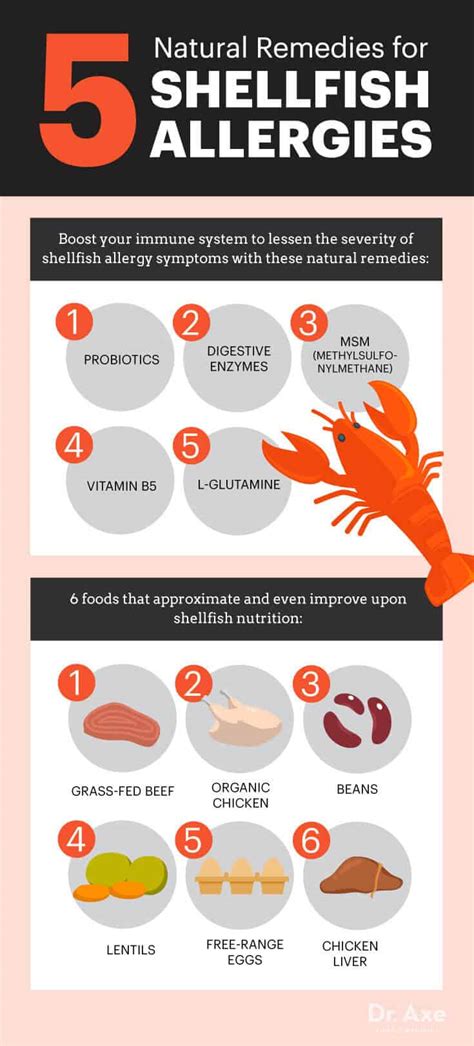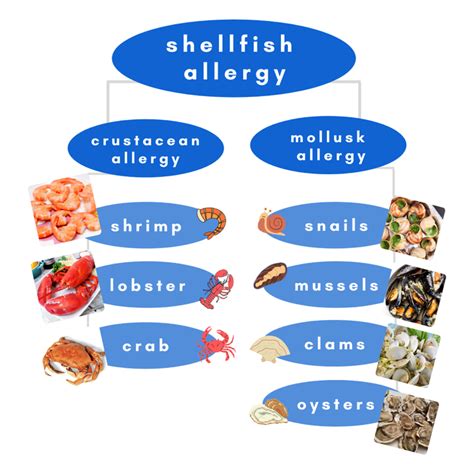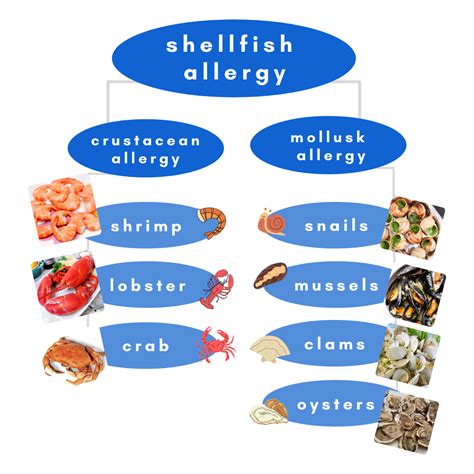Intro
Identify 5 shellfish allergy symptoms, including hives, itching, and digestive issues, and learn about anaphylaxis, a severe reaction requiring immediate medical attention, to manage shellfish intolerance and food allergies effectively.
Shellfish allergy is one of the most common food allergies, affecting millions of people worldwide. It is an adverse immune reaction to one of the proteins found in shellfish, such as shrimp, crab, lobster, and mollusks like oysters and clams. The symptoms of a shellfish allergy can range from mild to severe and can be life-threatening in some cases. Understanding the symptoms of a shellfish allergy is crucial for proper diagnosis and treatment.
Shellfish allergy is often associated with other allergies, such as dust mite allergy or pollen allergy, and can be a sign of a more generalized allergic condition. People with a shellfish allergy may experience symptoms within minutes of consuming shellfish, and in some cases, even the slightest exposure can trigger a reaction. The severity of the symptoms can vary depending on the individual, the amount of shellfish consumed, and the specific type of shellfish.
The importance of recognizing shellfish allergy symptoms cannot be overstated. A prompt diagnosis and treatment can help prevent serious complications, such as anaphylaxis, a life-threatening allergic reaction that requires immediate medical attention. Furthermore, understanding the symptoms of a shellfish allergy can help individuals take steps to avoid exposure and manage their condition effectively. In this article, we will delve into the common symptoms of a shellfish allergy, explore the underlying causes, and discuss the best ways to manage and treat this condition.
Common Shellfish Allergy Symptoms

The symptoms of a shellfish allergy can be divided into mild, moderate, and severe categories. Mild symptoms may include hives, itching, and swelling, while moderate symptoms can include stomach cramps, diarrhea, and vomiting. Severe symptoms, on the other hand, can include anaphylaxis, a life-threatening condition that requires immediate medical attention.
Some common shellfish allergy symptoms include:
- Hives or itchy skin
- Swelling of the face, lips, tongue, or throat
- Stomach cramps
- Diarrhea
- Vomiting
- Anaphylaxis
Understanding Anaphylaxis
Anaphylaxis is a severe, life-threatening allergic reaction that can occur within minutes of exposure to shellfish. The symptoms of anaphylaxis can include: * Constriction of the airways * Rapid heartbeat * Dizziness or fainting * Confusion or loss of consciousness * Severe itching or hivesCauses of Shellfish Allergy

The exact causes of a shellfish allergy are not fully understood, but research suggests that it is an immune system overreaction to one of the proteins found in shellfish. The immune system mistakenly identifies the protein as a threat and releases chemicals to fight it, leading to an allergic reaction.
Some possible factors that may contribute to the development of a shellfish allergy include:
- Genetic predisposition
- Environmental factors, such as exposure to shellfish at a young age
- Cross-reactivity with other allergies, such as dust mite or pollen allergy
Diagnosing Shellfish Allergy
Diagnosing a shellfish allergy typically involves a combination of medical history, physical examination, and diagnostic tests. The doctor may ask questions about the symptoms, including when they occur, how long they last, and any factors that trigger or relieve them.Some common diagnostic tests for shellfish allergy include:
- Skin prick test
- Blood tests, such as the radioallergosorbent test (RAST)
- Elimination diet, where the individual avoids shellfish for a period of time to see if the symptoms resolve
Treatment and Management

The treatment and management of a shellfish allergy typically involve avoiding exposure to shellfish and managing symptoms with medication. In severe cases, emergency medical treatment may be necessary.
Some common treatment options for shellfish allergy include:
- Antihistamines, such as diphenhydramine, to relieve mild symptoms
- Corticosteroids, such as prednisone, to reduce inflammation
- Epinephrine, such as an EpiPen, to treat anaphylaxis
Avoiding Shellfish
Avoiding shellfish is the most effective way to manage a shellfish allergy. This includes: * Reading food labels carefully to avoid hidden sources of shellfish * Asking questions about food ingredients when eating out * Avoiding cross-contamination with shellfish in food preparationLiving with Shellfish Allergy

Living with a shellfish allergy requires careful planning and attention to detail. Individuals with a shellfish allergy must be vigilant about avoiding exposure and managing symptoms.
Some tips for living with a shellfish allergy include:
- Carrying an EpiPen or other emergency medication at all times
- Wearing a medical alert bracelet or necklace
- Informing friends, family, and healthcare providers about the allergy
Support and Resources
There are many resources available for individuals with a shellfish allergy, including support groups, online forums, and educational websites.Some organizations that provide support and resources for individuals with food allergies include:
- Food Allergy Research & Education (FARE)
- Asthma and Allergy Foundation of America (AAFA)
- National Institute of Allergy and Infectious Diseases (NIAID)
Conclusion and Next Steps

In conclusion, a shellfish allergy is a serious condition that requires prompt diagnosis and treatment. Understanding the symptoms, causes, and treatment options is crucial for managing the condition effectively. By avoiding exposure to shellfish, managing symptoms with medication, and seeking support and resources, individuals with a shellfish allergy can lead active and healthy lives.
We invite you to share your experiences and questions about shellfish allergy in the comments below. If you or someone you know has a shellfish allergy, we encourage you to seek medical attention and explore the resources available to manage the condition.
What are the most common symptoms of a shellfish allergy?
+The most common symptoms of a shellfish allergy include hives, itching, swelling, stomach cramps, diarrhea, and vomiting. In severe cases, anaphylaxis can occur, which is a life-threatening condition that requires immediate medical attention.
How is a shellfish allergy diagnosed?
+A shellfish allergy is typically diagnosed through a combination of medical history, physical examination, and diagnostic tests, such as skin prick tests and blood tests.
What is the best way to manage a shellfish allergy?
+The best way to manage a shellfish allergy is to avoid exposure to shellfish and manage symptoms with medication. In severe cases, emergency medical treatment may be necessary.
Can a shellfish allergy be cured?
+Currently, there is no cure for a shellfish allergy. However, researchers are exploring new treatments and therapies that may help desensitize individuals to shellfish proteins.
What are some common hidden sources of shellfish?
+Some common hidden sources of shellfish include fish stock, Worcestershire sauce, and some types of breaded and fried foods. It is essential to read food labels carefully and ask questions about food ingredients when eating out.
